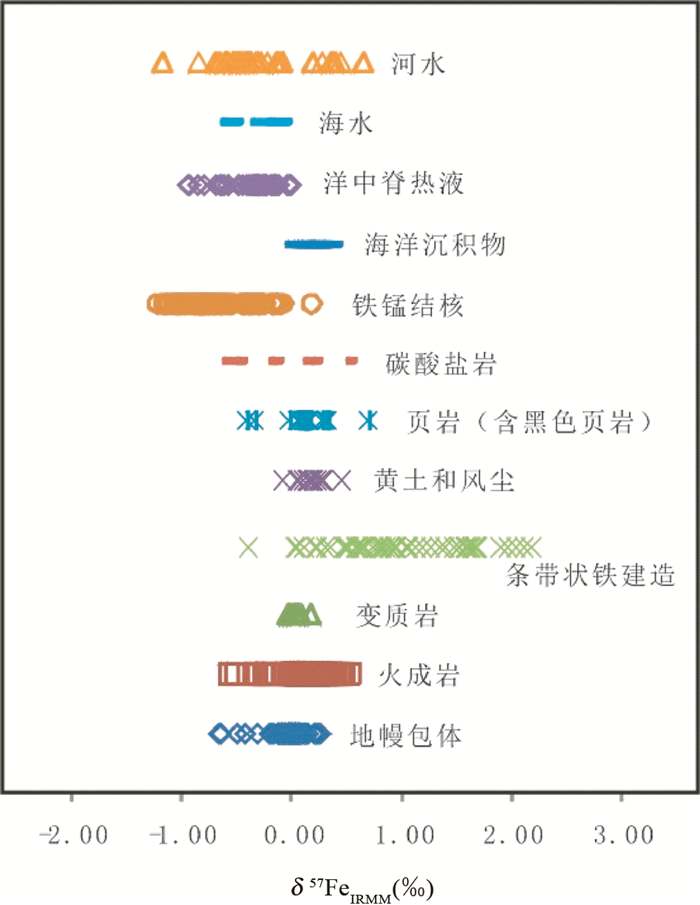铁是地球上丰度最高的变价元素,以不同的价态(0,+2,+3) 赋存于各类岩石、矿物、流体和生物体中,并广泛参与多种地球化学和生物化学过程。它是重要的成矿元素,主要工业矿物有磁铁矿、赤铁矿、褐铁矿、针铁矿、菱铁矿和含铁绿泥石等,是矿床学研究中重点关注的元素之一;它是与生命活动密切相关的元素,在自然界中的分布对生物活动有着重要影响;因此,铁同位素组成的研究在示踪成矿作用和生物演化等方面具有重要潜力。
铁有四个稳定同位素,分别为54Fe (5.84%)、56Fe (91.76%)、57Fe (2.12%) 和58Fe (0.28%) Valley and Anderson (1947)最早开展了对自然样品中铁同位素组成的调查,但限于当时的分析精度,没有发现自然样品的铁同位素组成存在变化。直至二十世纪九十年代末,自然样品的铁同位素组成变化才开始能够测定出来(Beard and Johnson, 1999, TIMS稀释剂法)。但由于分析测量方法误差(最好精度为0.56‰,2sd) 的限制,很多自然样品Fe同位素组成的真实变化仍无法精确测定。随着多接收器电感耦合等离子体质谱(MC-ICP-MS) 的诞生和发展,铁同位素测试精度有了大幅提高。Belshaw et al.(2000)首次建立了Fe同位素的MC-ICP-MS测量方法,将测量精度提高到0.03‰/amu,开创了Fe同位素研究的新纪元。近十余年来,铁同位素被广泛地应用于宇宙科学(Alexander and Wang, 2001;Alexander, 2004;Zipfel and Weyer, 2006;Zhu et al., 2000, 2001; Dauphas et al., 2004, 2007; Mullane et al., 2005; Poitrasson, and Freydier, 2005; Schoenberg et al., 2006)、地球科学(Beard and Johnson, 1999, 2004; Beard et al., 2003a, b; Zhu et al., 2000, 2001, 2002; Williams et al., 2004, 2005; Johnson et al., 2003, 2008; Dauphas et al., 2004, 2007; Rouxel et al., 2003, 2005; 李志红等, 2008a, b; 李志红和朱祥坤, 2012;朱祥坤等,2008;Wang et al., 2011)、环境科学(Beard et al., 2003; Fantle and DePaolo, 2004; Bergquist and Boyle, 2006) 和生物科学(Zhu et al., 2002;Walczyk and von Blanckenburg, 2002) 等研究领域。
近代矿床学的许多重大进展都与稳定同位素示踪技术的应用有关。但从金属矿床成矿作用讲,传统的H、C、O、S等稳定同位素对成矿物质来源与集聚过程的示踪毕竟是间接的,其主要研究对象是矿化剂元素,而不是矿化元素本身,因此研究仍带有一定的推断性和不确定性。近年来同位素测试技术的发展为运用铁同位素直接示踪铁的成矿作用提供了可能性。目前,国际上部分学者对铁同位素在矿床学领域的应用进行了开拓性的研究,包括:BIF (例如Johnson et al., 2003; Dauphas et al., 2004; Whitehouse and Fedo, 2007; 李志红等, 2008a, b; 闫斌等, 2010)、前寒武纪层状硫化物矿床(朱祥坤等, 2008)、赋存于太古代科马提岩中的Ni矿床(Bekker et al., 2009)、太古代砾岩型金矿床(Hofmann et al., 2009)、现代洋底热液系统(Sharma et al., 2001; Rouxel et al., 2004, 2008) 和斑岩-矽卡岩型矿床等与岩浆热液作用有关的矿床(Graham et al., 2004;Wang et al., 2011)、以及表生热液铁矿床(Markl et al., 2006)。这些研究既指示了铁同位素在示踪矿床形成机理等方面的潜力,又为今后的研究作了必要的数据积累。
本文对世界范围内不同含铁金属矿物的铁同位素研究成果进行了报道,并结合已发表的资料,对铁同位素体系及其在矿床学领域的应用进行基本总结。
2 各种储库中的铁同位素组成 2.1 铁同位素的基本概念和总体分布特征目前,国际上主要存在两种Fe同位素组成的表示方式:δ(千分偏差) 和ε(万分偏差)。Fe同位素的δ表达式为:δ56Fe=[(56Fe/54Fe)样品/(56Fe/54Fe)标样-1 ]×1000,δ57Fe=[(57Fe/54Fe)样品/(57Fe/54Fe)标样-1 ]×1000,△57FeA-B=δ57FeA-δ57FeB。对于质量分馏而言,δ56Fe=0.678 δ57Fe。由于自然界中有些样品的Fe同位素组成变化较小,千分偏差无法直观地显示Fe同位素的变化,所以有时采用万分偏差表示:ε56Fe=[(56Fe/54Fe)样品/(56Fe/54Fe)标样-1]×10000,ε57Fe=[(57Fe/54Fe)样品/(57Fe/54Fe)标样-1]×10000。两者之间的换算关系为:ε56Fe=10δ56Fe,ε57Fe=10δ57Fe。
目前国际上通用的Fe同位素标准物质有两种,一是火成岩标样,即15块地球火成岩和5块月球高钛玄武岩的平均值;二是欧洲委员会参考物质及测量协会提供的IRMM-014(Taylor et al., 1992)。两种标准物质间的换算关系为:δ56Fe火成岩=δ56FeIRMM-014-0.09‰,δ57Fe火成岩=δ57FeIRMM-014-0.11‰(Johnson et al., 2004)。
由于国际上各实验室所报道的Fe同位素组成的表达方式和标准物质有所不同,因此,对不同实验室的Fe同位素组成进行对比时,必须将各实验室的数据换算成统一的表达方式和标准,方可进行比较。本文所报道和引用的数据均已统一为相对于IRMM-014标准物质的千分偏差,未报道δ57Fe的文献均已对δ56Fe按质量分馏换算为δ57Fe,以便对比和总结。
已知的地球物质的δ57Fe的总体分布范围为-5.18‰~4.65‰,平均值为-0.34‰±1.79(n=1857),其中δ57Fe的最大值和最小值分别出现在条带状铁矿的磁铁矿单矿物样品(Whitehouse and Fedo, 2007) 和黑色页岩中的黄铁矿单矿物样品(Rouxel et al., 2005) 中。从全岩尺度上讲,地幔包体、火成岩、变质岩、沉积岩、黄土和风尘、沉积物以及洋底热液和海水均呈现出较小的铁同位素组成分布范围,铁同位素组成相对均一,而条带状铁建造和河水样品具有较大的铁同位素组成变化范围;条带状铁建造呈现出富集铁的重同位素的基本特征,碳酸盐岩、铁锰结核、海水、河水和洋中脊热液流体呈现出富集铁的轻同位素的特征,地幔包体、火成岩、黄土、风尘和页岩集中分布在零值附近(图 1),这种分布特征主要是由于地幔熔融、结晶分异等过程中铁同位素的分馏程度相对较小,而氧化还原过程中的铁同位素分馏相对较大所导致的。
Beard et al. (2003b)最早通过对MORBs和OIBs的铁同位素研究,结合Zhu et al.(2002)的研究,对整体地球的平均铁同位素组成进行了约束。他们认为,整体地球的δ57Fe平均值应该位于0.15‰附近。其后的研究广泛引用了这一平均值作为整体硅酸盐地球的参考基点。但该数值是基于早期研究的有限样品所得出的平均值,随着近年来大量研究深入细致的开展,铁同位素组成的数据库得到了极大程度的积累和更新,因此,重新对整体硅酸盐地球的铁同位素组成进行约束非常必要。为此,本文对近年来报道的陨石、上地幔和地壳的铁同位素组成进行了系统的总结和讨论,以期为今后的研究提供一个更为精确的整体地球参考基点。
2.2.1 陨石Zhu et al.(2000, 2001)、Dauphas et al.(2004, 2007)、Mullane et al.(2005)、Poitrasson et al.(2004)、Poitrasson and Freydier (2005)、Schoenberg et al.(2006)、Needham et al.(2009)、Hezel et al.(2010)和Teng et al.(2011)先后对铁陨石、石铁陨石和石陨石的全岩样品进行了铁同位素组成的分析(表 1)。统计表明,普通球粒陨石的δ57Fe变化范围为-0.20‰~0.27‰,平均值为(0.05±0.15)‰(n=21);碳质球粒陨石的δ57Fe变化范围为-0.22‰~0.19‰,平均值为(0.01±0.16)‰ (n=10);顽火辉石球粒陨石的δ57Fe变化范围为-0.05‰~0.03‰,平均值为(-0.01±0.06)‰(n=5);无球粒陨石的δ57Fe变化范围为-0.07‰~0.25‰,平均值为(0.02±0.07)‰ (n=12);铁陨石的δ57Fe变化范围为0.01‰~0.23‰,平均值为(0.10±0.14)‰ (n=23)。
|
|
表 1 陨石中的铁同位素组成特征 Table 1 Fe isotope compositions of meteorites |
一般认为碳质球粒陨石代表了太阳系的初始物质(欧阳自远,1988)。因此,碳质球粒陨石的铁同位素组成能够为地球初始物质的铁同位素组成提供重要参考。上述统计数据显示,不同类型的陨石具有大致相同的铁同位素组成分布范围和基本一致的平均值,说明不同类型的陨石具有均一的铁同位素组成。因此,我们有理由认为,地球物质的铁同位素组成应该与陨石的总体平均值接近,位于0.05±0.14‰附近。
2.2.2 上地幔上地幔部分的铁同位素组成可以通过地幔包体和地幔部分熔融形成的玄武岩的平均铁同位素组成进行约束。Zhu et al.(2002)、Beard and Johnson (1999)、Beard et al.(2003b)、Poitrasson et al. (2004)、Williams et al.(2004, 2005)、Weyer et al.(2005)、Dauphas et al.(2004)、Weyer and Ionov (2007)、Heimann et al.(2008)、Teng et al.(2008, 2011)、Zhao et al.(2010, 2011)、Huang et al.(2011)、Weyer and Seitz (2011)先后对来自地幔的岩石样品(样品类型包括纯橄榄岩、尖晶石二辉橄榄岩、斜方橄榄岩、二辉橄榄岩和二辉辉石岩等) 进行了全岩的Fe同位素组成分析。统计结果显示,δ57Fe的总体变化范围为-0.64‰~0.40‰,平均值为0.01±0.22‰(n=126)。其中,纯橄榄岩的δ57Fe的变化范围为-0.56‰~0.28‰,平均值为-0.03±0.24‰;尖晶石二辉橄榄岩的δ57Fe的变化范围为-0.31‰~0.15‰,平均值为-0.01±0.16‰;斜方橄榄岩的δ57Fe的变化范围为-0.10‰~0.24‰,平均值为-0.01±0.12‰;二辉橄榄岩的δ57Fe的变化范围为-0.64‰~0.13‰,平均值为-0.06±0.34‰;二辉辉石岩的δ57Fe的变化范围为-0.64‰~0.40‰,平均值为0.03±0.36‰。上述统计结果说明:上地幔的铁同位素组成并不均一,但全岩样品的变化范围不是很大。已分析的样品包括不同大地构造背景和不同的岩石类型,因此这些样品的平均值应基本代表上地幔的平均铁同位素组成,即δ57Fe=0.01±0.22‰。实际上,这一平均值与陨石的铁同位素组成平均值非常接近(表 1)。
玄武岩是地幔部分熔融形成的产物,如果地幔部分熔融的过程中没有发生明显的铁同位素分馏,其铁同位素组成能够代表地幔的平均铁同位素组成。前人对不同地区和构造背景下形成的玄武岩进行了Fe同位素组成的测定分析。统计结果显示,玄武岩的δ57Fe的变化范围为-0.56‰~0.37‰,平均值为0.11±0.20‰,相对于地幔橄榄岩富集铁的重同位素(图 2)。
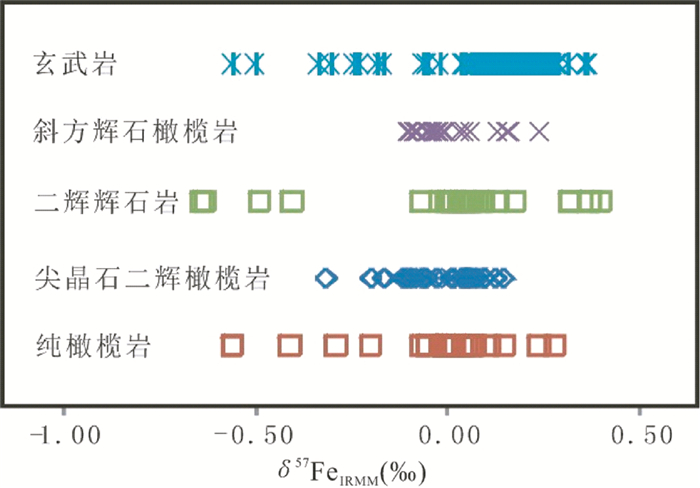
|
图 2 地幔橄榄岩及部分熔融后的火成岩的铁同位素组成 数据引自Dauphas et al., 2004, 2010; Beard and Johnson, 1999; Beard et al., 2003b; Fantle and DePaol, 2004; Heimann et al., 2008; Schoenberg and von Blanckenburg, 2006; Weyer et al., 2005; Weyer and Ionov, 2007; Weyer and Seitz, 2011; 赵新苗等,2008; Zhao et al., 2010, 2011; Teng et al., 2011; Schuessler et al., 2009; Beard and Johnson, 2004a, b; Huang et al., 2011; Williams et al., 2005 Fig. 2 Variation of Fe isotope composition in mantle rocks, basalt and komatiite |
前人的研究结果认为,地幔的部分熔融过程中Fe同位素发生分馏(Williams et al., 2004, 2005; Weyer et al., 2005; Weyer and Ionov, 2007; Shuessler et al., 2007; Weyer, 2008; Huang et al., 2009, 2011; Zhao et al., 2010, 2011)。因此,上地幔的平均铁同位素组成应该位于地幔岩石所约束的平均值δ57Fe=0.01±0.22‰附近。研究普遍认为,部分熔融的过程中Fe同位素发生分馏,熔体富集重Fe同位素,残余地幔富集轻Fe同位素,说明地幔熔融的过程中的Fe同位素分馏是导致玄武岩相对富集铁的重同位素的主要原因,这也解释了我们所获得的整体地球平均组成相对于Beard et al. (2003b)所报道的整体地球的平均值(0.11‰) 富集铁的轻同位素的现象,因为Beard et al. (2003b)所报道的平均值主要是基于不同类型的玄武岩获得的。
2.2.3 地壳上地壳部分的铁同位素组成可以通过页岩和黄土的平均铁同位素组成进行约束。Zhu et al.(2000)和Beard et al.(2003b)先后报道了中国、美国、德国和新西兰的黄土样品的铁同位素组成,δ57Fe的变化范围为-0.06‰~0.48‰,平均值为0.21±0.24‰。Beard et al.(2003b)和Rouxel et al.(2005)先后对页岩样品进行了Fe同位素测试,δ57Fe的变化范围为-0.39‰~0.71‰,集中分布在0~0.30‰之间,平均值为0.11±0.42‰。结合页岩和黄土的Fe同位素数据,推测上地壳的平均铁同位素组成为0.14±0.38‰(表 2)。
|
|
表 2 黄土和页岩的铁同位素组成 Table 2 Fe isotope compositions of loess and shales |
另外,Beard et al.(2003b)、Dauphas et al.(2004)、Poitrasson et al.(2004)、Poitrasson and Freydier (2005)、Heimann et al.(2008)、Schuessler et al.(2009)对不同时间、地点、构造背景下形成的花岗岩、安山岩、流纹岩、花岗闪长岩进行了Fe同位素组成的研究。统计结果显示,这些火成岩总体的δ57Fe的变化范围为0.01‰~0.54‰,平均值为0.18±0.00‰(n=76),随着演化程度的增加,不同类型的火成岩的平均铁同位素组成略呈现逐渐变重的趋势(表 3)。因为所测定的火成岩分布很广且具有很宽泛的物质组成和不同的物质来源,所以数据可以代表上地壳结晶部分的铁同位素组成。
|
|
表 3 不同类型火成岩的Fe同位素组成 Table 3 Fe isotope compositions of different-type igneous rocks |
这些储体的平均铁同位素组成共同说明,整体硅酸盐地球的平均Fe同位素组成与Fe同位素标准物质IRMM-014非常接近;并且,上地壳相对地幔略富集铁的重同位素,富集程度较小(~0.18‰左右)。
3 铁同位素在含铁矿物和不同体系中的分布特征 3.1 不同含铁矿物的铁同位素组成特征铁的硫化物(如黄铁矿、黄铜矿)、铁的氧化物(如磁铁矿、赤铁矿)、铁的碳酸盐矿物(如菱铁矿) 是成矿作用下形成的主要含铁矿物。为了更好地了解并约束不同含铁矿物的铁同位素组成的基本分布特征,我们选取了世界范围内以Fe为主要元素的赤铁矿、磁铁矿、菱铁矿和黄铜矿样品进行了Fe同位素组成的测试分析,样品均来自英国牛津大学自然历史博物馆。
完全溶解后的样品采用Zhu et al. (2000)的分离方法实现铁与其它元素的分离。铁同位素的测定在英国剑桥大学同位素实验室的Nu Plasma型多接受电感耦合等离子体质谱仪(MC-ICP-MS) 上进行,采用标准-样品交叉法对仪器的质量分馏进行校正(Zhu et al., 2000;Belshaw et al., 2000)。化学分离后的样品溶入0.1mol HNO3介质中,通过自动进样器和DSN-100型膜去溶进入等离子体火炬离子化,进样浓度为10×10-6,样品和标准样品之间分别用10%和1%的HNO3清洗各5min。数据采用牛津大学Belshaw博士提供的基于Unix操作系统的控制软件进行自动采集,每组数据采集之前进行20s的背景测定。实验所用的H2O经Millipore系统纯化,电阻为18.2MΩ,HCl和HNO3为优级纯试剂在超净室经二次亚沸蒸馏纯化得到。铁同位素的测定结果以样品相对于标准物质(IRMM-014) 的千分偏差表示。结果显示,不同矿物之间和不同地区的同种含铁矿物铁同位素组成均存在很大差别(表 4)。
|
|
表 4 世界范围内不同含铁矿物的铁同位素组成 Table 4 Fe isotope compositions of different Fe-bearing minerals worldwide |
新获得的数据和前人所报道的数据共同显示,主要含铁矿物δ57Fe的总体变化范围为-5.18‰~4.65‰,平均值为-0.37±3.00‰(n=778),不同含铁矿物的Fe同位素组成存在较大的差异,同种矿物自身的铁同位素组成也具有较大的变化范围。其中,相对于硫化物和碳酸盐矿物,磁铁矿和赤铁矿是较为富集铁的重同位素的矿物相,主要赋存在BIF和热液矿床中,相对于BIF中的磁铁矿和赤铁矿,热液矿床中磁铁矿和赤铁矿的分布范围较小且相对富集铁的轻同位素;黄铁矿具有最大的铁同位素组成变化范围和最负的δ57Fe值,主要赋存在不同时代的沉积物、洋底热液体系和不同类型的矿床中,相对于热液体系和热液矿床中的黄铁矿,太古宙沉积物中的黄铁矿具有相对轻的铁同位素组成和相对较大的变化范围,其分布特征主要与地球早期环境有关,超出本文的研究范畴,在此不作详细的讨论(图 3)。
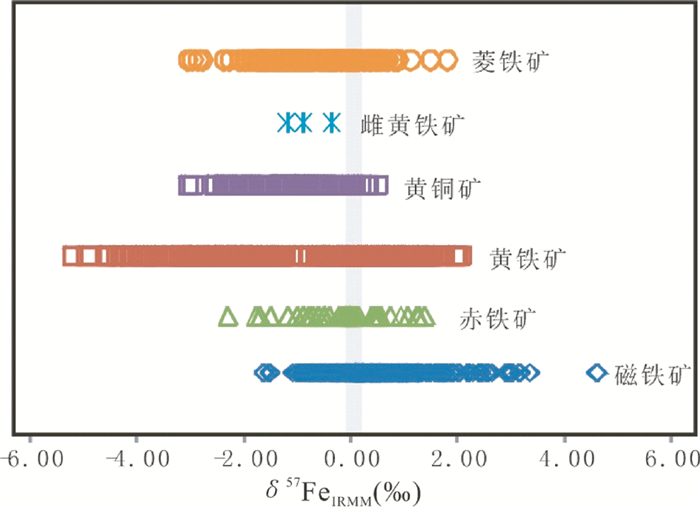
|
图 3 不同含铁矿物中的铁同位素组成 图中数据为本次研究所报道数据和引用数据,灰色阴影为本次研究所约束的整体硅酸盐地球.数据引自: Sharma et al., 2001; Beard et al., 2003b; Johnson et al., 2003; Graham et al., 2004; Rouxel et al., 2004, 2005, 2008; Dauphas et al., 2004, 2007; Yamaguchi et al., 2005; Markl et al., 2006; Dauphas and Rouxel, 2006; Dauphas et al., 2007; Johnson and Beard, 2006; Frost et al., 2007; Whitehouse and Fedo, 2007; Anbar and Rouxel, 2007; Johnson et al., 2008; Heimann et al., 2008, 2010; Hyslop et al., 2008; 李志红等, 2008a; 朱祥坤等, 2008; Hofmann et al., 2009;Schoenberg et al., 2009; 闫斌等, 2010; Steinhoefel et al., 2009,2010; Planavsky et al., 2009, 2011; Czaja et al., 2010; Tsiko et al., 2010; Halverson et al., 2011; Craddock and Dauphas, 2011; Wang et al., 2011; 李志红和朱祥坤, 2012; 王世霞等,2011 Fig. 3 Fe isotope compositions of different Fe-bearing minerals |
上述研究结果显示,不同地区不同矿床类型的含铁矿物间铁同位素组成存在差异,但目前尚不清楚这种差异究竟是由不同成矿作用过程中Fe同位素地球化学行为的不同导致的还是由于矿物本身的铁同位素分配情况所导致,对这一问题的正确认识是利用铁同位素示踪成矿作用过程的基本前提。为了更为精细地掌握不同含铁矿物间的铁同位素组成分布特征,下面将对同一矿床类型中的不同含铁矿物的铁同位素组成开展对比研究。这一对比研究主要包括同一类型矿床中不同价态的共生矿物间以及同一价态的共生矿物间的铁同位素组成分布规律研究两个方面。
3.1.1 铁同位素在不同价态矿物间的分布对铁同位素在共生矿物间分配规律的研究,不仅是同位素分馏理论体系构筑不可或缺的组成部分;同时,对这一问题的正确认识将为铁同位素体系在成岩成矿研究中的应用奠定必要的理论基础。
Fe (Ⅱ) 矿物(硫化物和碳酸盐矿物) 和Fe (Ⅲ) 矿物(氧化物) 广泛分布于各类矿床中。前人对BIF矿床和热液脉型矿床中的Fe (Ⅲ) 矿物和Fe (Ⅱ) 矿物进行了铁同位素组成的对比研究(Johnson et al., 2003, 2008; 李志红等,2008b;Steinhoefel et al., 2010; Craddock et al., 2011; Markl et al., 2006)。统计结果显示,同一类型矿床中,不同价态的矿物间Fe同位素组成存在差异,Fe (Ⅲ) 矿物和Fe (Ⅱ) 矿物之间的铁同位素组成呈现出两种截然相反的分布规律。第一种规律表现为相对于Fe (Ⅲ) 矿物磁铁矿和赤铁矿,Fe (Ⅱ) 矿物黄铁矿富集铁的轻同位素(例如,Johnson et al., 2003, 2008; Steinhoefel et al., 2010; Markl et al., 2006等);第二种规律表现为相对于磁铁矿,黄铁矿富集铁的重同位素(例如,李志红等,2008b)。这说明,至少有一个体系的矿物间没有达到同位素平衡。
理论计算表明,同位素体系达到平衡时,相对铁的氧化物,黄铁矿应该最为富集铁的重同位素(Polyakov et al., 2007; Polyakov and Soultanov, 2011)(图 4)。第二种规律与理论计算结果相一致,说明了铁的氧化物(磁铁矿) 和黄铁矿之间达到了同位素体系的平衡,共生的黄铁矿相对铁的氧化物富集铁的重同位素,这与两种矿物的晶体结构上的差异有关,具体情况还有待于进一步的研究;而第一种规律反映的则是Fe (Ⅲ) 溶液和Fe (Ⅱ) 溶液之间的铁同位素分馏,矿物间并未达到同位素平衡。
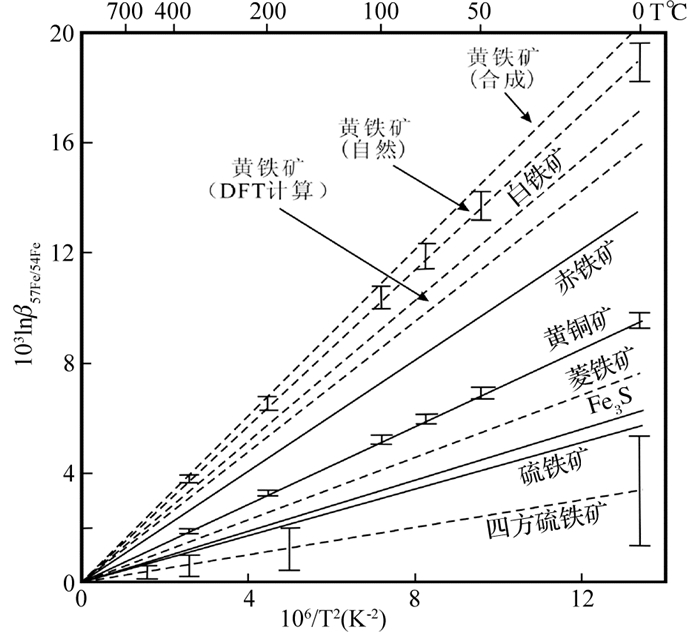
|
图 4 理论计算的不同矿物间的Fe同位素分馏(据Polyakov and Soultanov, 2011) Fig. 4 Equilibrium iron isotope fractionation for different minerals (after Polyakov and Soultanov, 2011) |
前人对斑岩-矽卡岩型矿床、热液脉型矿床和洋底热液系统内共生的黄铁矿和黄铜矿进行了铁同位素组成的对比研究(图 5)。现有研究结果表现为两种截然相反的趋势:一是相对于黄铜矿,黄铁矿富集铁的重同位素(Graham et al., 2004; Markl et al., 2006; Wang et al., 2011);二是相对于黄铜矿,黄铁矿富集铁的轻同位素(Rouxel et al., 2004, 2008)。这说明,两个矿物对研究中至少有一个同位素体系没有达到平衡。
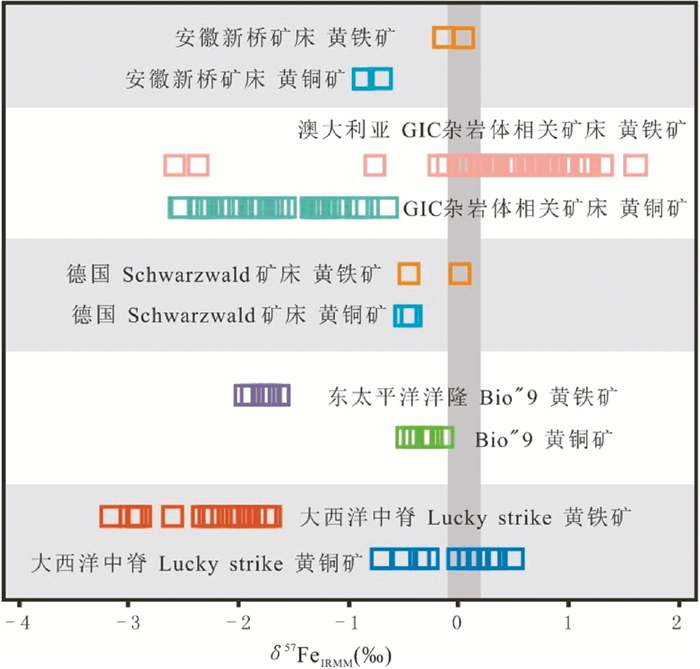
|
图 5 黄铜矿-黄铁矿矿物对中的铁同位素组成 数据引自Graham et al., 2004; Markl et al., 2006; Rouxel et al., 2004, 2008;Wang et al., 2011,灰色区域为本次研究所约束的整体硅酸盐地球 Fig. 5 Fe isotope compositions of pyrite-chalcopyrite mineral pair |
Polyakov and Mineev (2000)、Polyakov et al.(2007)与Polyakov and Soultanov (2011)先后对黄铁矿和黄铜矿之间的分馏系数进行了理论计算。计算结果显示,共生的黄铁矿和黄铜矿间存在铁同位素组成的差异,相对于黄铜矿,黄铁矿富集铁的重同位素(图 4)。
前人的理论研究表明,如果两种矿物的键长不同,其相应的振动频率也有所不同,两种矿物间存在质量分馏,轻同位素优先进入键长较长、键能较弱的矿物(O’Neil,1986)。黄铜矿(CuFeS2) 为单硫化物,其阴离子为S2-;而黄铁矿(FeS2) 为对硫化物,其阴离子为[S2]2-。对阴离子之间具有强烈的共价键,其键长很短,对硫离子中S-S之间的距离小于二倍硫离子半径之和。相对于黄铜矿,黄铁矿的键长较短、键能较强。也就是说,从理论上讲,相对于黄铜矿,黄铁矿应当富集重同位素,这一理论得到了硫同位素研究结果的支持(Bachinski, 1969)。
理论研究和计算结果与Graham et al. (2004)、Markl et al. (2006)和Wang et al.(2011)所报道的结果一致,这说明Rouxel et al.(2004, 2008) 的研究中黄铁矿与黄铜矿间的铁同位素没有达到平衡或黄铁矿与黄铜矿不是共生矿物。共生的黄铜矿和黄铁矿之间存在铁同位素组成的差异,相对于黄铁矿,共生的黄铜矿富集铁的轻同位素,精确的铁同位素分馏系数还有待于进一步的确定。
3.2 不同硅酸盐矿物的铁同位素组成特征铁硅酸盐矿物虽然不是以Fe为主要元素的矿物,但其与岩浆矿床成矿作用有着密切的联系。前人对不同铁硅酸盐矿物的Fe同位素组成进行了研究。统计结果表明,主要的硅酸盐矿物δ57Fe的总体变化范围为-1.68‰~1.16‰,平均值为-0.02±0.43‰。不同硅酸盐矿物的Fe同位素组成存在一定的差异。总体上,除黑云母矿物(现有数据量较少,n=25) 外,其余矿物按照鲍文反应序列,从橄榄石→斜方辉石→单斜辉石→角闪石,平均铁同位素组成逐渐变重,橄榄石最为富集铁的轻同位素(图 6)。
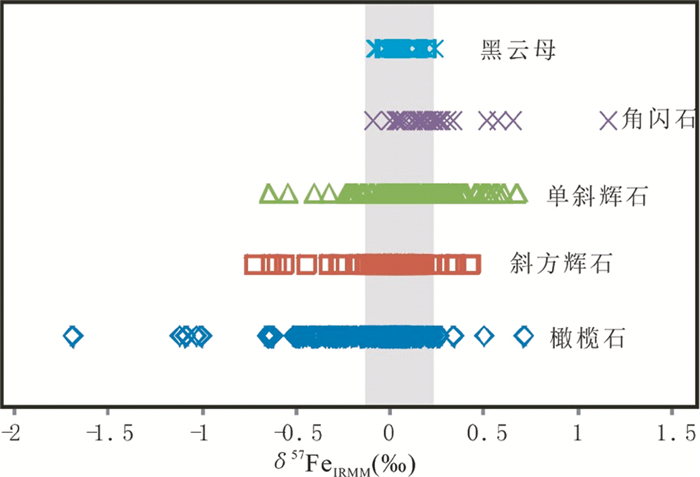
|
图 6 不同硅酸盐矿物中的铁同位素组成 数据引自Zhu et al., 2002; Dauphas et al., 2007; Bead et al., 1999, 2003b; Beard and Johnson, 2004a; Schoenberg et al., 2009; Johnson et al., 2010; Weyer et al., 2005; Williams et al., 2005; Heimaan et al., 2008; Schuessler et al., 2009; Teng et al., 2008, 2011; Zhao et al., 2010, 2011; Huang et al., 2011.灰色区域为本次研究所约束的整体硅酸盐地球 Fig. 6 Fe isotope compositions of different silicate minerals |
王世霞等(2011)最新报道了攀枝花钒钛磁铁矿矿石中橄榄石、辉石和角闪石的Fe同位素分布特征,研究发现橄榄石具有相对最轻的Fe同位素组成,辉石次之,角闪石的Fe同位素线组成相对偏重。
目前对岩浆结晶分异过程中的Fe分馏的研究较少,并且存在较大争议(Teng et al., 2008, 2011; Heimann et al., 2008; Weyer et al., 2008; Schuessler et al., 2009; Dauphas et al., 2010; Huang et al., 2011; Zhao et al., 2010, 2011),但上述不同硅酸盐矿物间的总体分布特征可能说明,在岩浆结晶演化的过程中单矿物尺度铁同位素发生分馏。
3.3 BIF的铁同位素组成变化规律Johnson et al.(2003)、Dauphas et al.(2004, 2007)、Rouxel et al.(2005)、Frost et al.(2007)、Whitehouse and Fedo (2007)、Anbar and Rouxel (2007)、Dauphas and Rouxel (2006)、Johnson and Beard (2006)、Johnson et al. (2008)、李志红等(2008a,b,2012)、闫斌等(2010)、Steinhoefel et al.(2009, 2010)、Planavsky et al.(2009, 2011)、Czaja et al.(2010)、Tsiko et al.(2010)、Heimann et al.(2010)和Halverson et al.(2011)、Craddock et al.(2011)先后对世界范围内的太古宙和元古宙条带状铁建造进行了铁同位素组成的研究。现有数据显示,条带状铁建造的整体分布范围为δ57Fe=-3.02‰~4.65‰,最大值出现在磁铁矿单矿物中,最小值出现在菱铁矿单矿物中。世界范围内的条带状铁矿都具有大致相似的Fe同位素组成特征,即总体上显示Fe的重同位素富集的特征。那么,根据质量平衡原理,在同时间段的沉积记录中,应当存在一个与之对应的富集Fe的轻同位素的储体。
朱祥坤等(2008)认为,在BIF的形成过程中,随着磁铁矿和赤铁矿沉淀的进行,海水中残留的Fe2+的同位素组成逐渐变轻。在特定环境下,这些残留的Fe2+与CO32-、S2-结合,形成富集Fe的轻同位素的碳酸盐和硫化物。前人研究结果显示,沉积物中的黄铁矿的整体铁同位素组成变化范围为δ57Fe=-5.31‰~1.72‰,总体上显示出铁的轻同位素富集的特征,这种铁的轻同位素的富集特征在2.3Ga之前尤其明显,总体上随着氧逸度和时间发生演化(Johnson et al., 2003; Rouxel et al., 2005; Yamaguchi et al., 2005; Archer and Vance, 2006; Severmann et al., 2006; Anbar and Rouxel, 2007; Clayton et al., 2007; von Blanckenburg et al., 2008; 朱祥坤等, 2008; Fehr et al., 2008; Hofmann et al., 2009; Bekker et al., 2010)。Johnson et al.(2003, 2008) 和Frost et al. (2007)对早寒武纪BIF中的菱铁矿和碳酸盐的铁同位素研究结果显示,早前寒武纪的菱铁矿δ57Fe变化范围介于-3.0‰~1.53‰之间,总体上具有富集Fe的轻同位素的特征。朱祥坤等(2008)和Planavsky et al.(2011)认为,太古代沉积物中的黄铁矿和BIF中的菱铁矿可能能够代表与BIF形成过程相对应的富集铁的轻同位素的储体。
现有研究表明,铁同位素在示踪地球早期演化等方面具有巨大的潜力。具体有关BIF富集Fe的重同位素和太古代沉积物中的黄铁矿和早前寒武纪的菱铁矿富集Fe的轻同位素这一特征的形成机理和如何利用Fe同位素对地球早期Fe循环进行制约超出了本文的讨论范围,在此不作深入讨论。
3.4 洋底热液体系的铁同位素组成变化规律前人先后对Juan de Fuca洋中脊、大西洋中脊的Lucky Strike、Rainbow、Logatchev和5°S热液场以及东太平洋隆(EPR) 的热液流体和颗粒物质(主要由铁的硫化物黄铁矿、黄铜矿和铁的氢氧化物组成) 进行了铁同位素组成的分析测定(Beard et al., 2003b; Rouxel et al., 2004, 2008; Bennett et al., 2009; Severmann et al., 2004; Sharam et al., 2001)。统计结果显示,热液流体的整体铁同位素组成变化范围为δ57Fe=-1.00‰~-0.06‰,平均δ57Fe为-0.39±0.34‰;地幔柱颗粒的整体铁同位素组成变化范围为δ57Fe=-3.16‰~1.20‰,平均δ57Fe为-0.57±1.24‰。总体上,流体和地幔柱颗粒之间存在铁同位素组成的差异,相对于流体,地幔柱颗粒富集Fe的轻同位素。
4 铁同位素示踪成矿作用过程流体出溶、流体演化、成矿作用过程和成矿物质来源是矿床学的重点研究对象。目前,对铁同位素在矿床学中的应用研究较少,对与岩浆热液体系有关的矿床研究更少,仅Graham et al. (2004)、Markl et al. (2006)和Wang et al.(2011)等对与热液作用有成因关系的矿床进行了研究,但这些研究仍显示出铁同位素在指示成矿流体演化、成矿物质来源和成矿后的表生蚀变作用过程方面具有可能性。本文对前人的这些工作进行系统的总结和归纳,得出铁同位素示踪在这些方面的一些规律。
4.1 流体出溶过程中的铁同位素分馏流体出溶是成矿作用过程中的一个关键的过程,对这一过程中Fe同位素的地球化学行为的了解可以为成矿物质来源和矿化作用过程的制约提供重要信息。
Wang et al.(2011)通过对长江中下游铁铜成矿带铜陵矿集区新桥矿床中与流体出溶过程密切相关的端元组分的Fe同位素组成对比研究发现,近岩体矽卡岩和最早形成的含铁金属矿物磁铁矿相对于岩体均富集铁的轻同位素(分别为约1.2‰和约0.3‰)。他们认为,流体从岩体中出溶的过程中铁同位素发生分馏,相对于岩体,出溶的流体中富集铁的轻同位素。流体出溶过程中的铁同位素分馏是导致矽卡岩和磁铁矿相对于成矿岩体富集铁的轻同位素的主要原因。陈晓峰和朱祥坤(2011)对长江中下游地区鄂东南矿集区铜绿山矽卡岩型矿床进行了Fe同位素组成的研究,研究结果显示,最早晶出的矿物相磁铁矿相对于岩体富集铁的轻同位素(约0.2‰),结合围岩的Fe含量很低以及Fe含量与δ57Fe的负相关关系,他们认为这种Fe的轻同位素富集的特征不是由围岩组分加入导致的,而是因为从岩浆出溶的初始流体富集铁的轻同位素。
前人研究发现,不同类型火成岩之间存在Fe同位素组成的差异,虽然这种差异较小,但总体上呈现出高分异的火成岩相对富集铁的重同位素的特征(Poitrasson and Freydier, 2005; Weyer et al., 2005; Beard and Johnson, 2006, 2007; Poitrasson, 2006, 2007; Schoenberg and von Blanckenburg et al., 2006; Weyer and Ionov, 2007; Schoenberg et al., 2009)。目前,对这种差异的形成机制仍存在较大争议。
Chou and Eugster (1977)的研究表明,起源于岩浆的岩浆流体或热液流体中的Fe以FeCl20形式存在。Heimann et al. (2008)的理论预测表明,相对于磁铁矿和硅酸盐熔体,铁的氯化物中富集铁的轻同位素。结合Chou and Eugster (1977)的研究,Heimann et al.(2008)提出了流体出溶的机制来解释高分异的火成岩富集铁的重同位素的特征,即认为从岩浆中出溶的初始流体可能富集铁的轻同位素,从而导致火成岩富集铁的重同位素。Wang et al.(2011)、陈晓峰和朱祥坤(2011)所得出的流体出溶过程中铁同位素发生分馏的结论支持Heimann et al. (2008)提出的这一机制。
上述实测和理论研究共同表明,流体出溶的过程中铁同位素发生分馏,相对于岩体,出溶的流体富集铁的轻同位素。
4.2 流体演化过程中的铁同位素分馏流体演化过程是矿床学领域的重点研究对象,正确反演成矿流体演化历史可以为矿化作用过程和矿床成因的研究提供关键信息。
铁的主要矿物有硫化物(黄铁矿、黄铜矿等)、氧化物(磁铁矿、赤铁矿等)、氢氧化物(针铁矿等) 和碳酸盐矿物(菱铁矿) 等。Butler et al. (2005)对无氧环境下四方硫铁矿(FeS) 的沉淀过程中的铁同位素分馏情况进行了实验研究。实验结果发现,相对于Fe (Ⅱ) 溶液,硫化物沉淀优先摄取铁的轻同位素。Wiesli et al.(2004)对菱铁矿的沉淀过程中的Fe同位素分馏进行了实验研究,研究结果显示,相对于Fe (Ⅱ) 溶液,菱铁矿沉淀优先摄取铁的轻同位素, Δ56FeFe (Ⅱ) aq-Fe (Ⅱ) 菱铁矿=0.48‰。Johnson et al. (2002)和Welch et al. (2003)对Fe (Ⅱ)aq和Fe (Ⅲ)aq之间的平衡分馏进行了实验研究。其中,Johnson et al. (2002)的实验研究结果显示,在22℃时,Δ56FeFe (Ⅲ) aq-Fe (Ⅱ) aq=2.75‰;Welch et al. (2003)的实验研究显示,在22℃时,Δ56FeFe (Ⅲ) aq-Fe (Ⅱ) aq=3.0‰,在0℃时,Δ56FeFe (Ⅲ) aq-Fe (Ⅱ) aq=3.57‰。Balci et al. (2006)研究了无生物氧化Fe (Ⅱ)aq生成Fe (Ⅲ)aq过程中的Fe同位素分馏情况,实验结果显示,Δ56FeFe (Ⅲ) aq-Fe (Ⅱ) aq=3.4‰。Anbar et al. (2005)使用密度函数对Fe (Ⅱ)aq与Fe (Ⅲ)aq之间的平衡分馏进行了理论预测,结果显示,在22℃时,Δ56FeFe (Ⅲ) aq-Fe (Ⅱ) aq≈3 ‰,与分馏实验结果非常符合。Polyakov and Mineev (2000)、Polyakov et al.(2007, 2011) 先后对四方硫铁矿、菱铁矿和赤铁矿等矿物沉淀过程中的平衡分馏进行了理论计算和模拟,理论预测显示出相对于四方硫铁矿和菱铁矿,赤铁矿富集铁的重同位素的特征(图 4)。
分馏实验和理论计算的结果非常一致地说明,Fe (Ⅱ)aq和Fe (Ⅲ)aq间存在分馏,相对于Fe (Ⅱ)aq,Fe (Ⅲ)aq富集铁的重同位素;Fe (Ⅱ)aq和Fe (Ⅱ)矿物间存在铁同位素组成的差异,相对于Fe (Ⅱ)aq,四方硫铁矿和菱铁矿富集铁的轻同位素。
前人对洋底热液系统、热液脉型矿床和热液交代矿床的实测结果与上述实验和理论模拟结果一致。Sharam et al.(2001)、Beard et al.(2003b)、Severmann et al.(2004)、Rouxel et al.(2004, 2008)、Bennett et al.(2009)对洋底热液体系中的流体和颗粒样品进行了铁同位素组成的直接测定。测定结果表明,以铁的硫化物为主的地幔柱颗粒具有比对应的流体轻的铁同位素组成,即颗粒富集铁的轻同位素,流体富集重同位素(详见3.4节);Markl et al.(2006)对Schwarzwald热液脉型矿床中的原生菱铁矿、赤铁矿的铁同位素组成进行了研究。研究结果发现,沉淀自初始流体的原生赤铁矿和原生菱铁矿的铁同位素有较大不同,相对于初始流体,原生赤铁矿富集铁的重同位素,而原生菱铁矿富集铁的轻同位素(图 7);Wang et al.(2011)对新桥矿床中的含铁矿物按照矿物生成顺序进行了Fe同位素组成的对比研究。研究发现,相对最早期形成的磁铁矿,其后形成的硫化物富集铁的轻同位素;对于硫化物来讲,相对早期的硫化物,晚期的硫化物富集铁的重同位素,表现出铁同位素的时间分带性(图 8a)。他们同时还对不同空间位置的黄铁矿进行了Fe同位素组成的对比研究。研究发现,不同空间位置,从近岩体矽卡岩→矽卡岩型矿体→近围岩矽卡岩,随着远离岩体,含矿流体向外迁移,硫化物的Fe同位素组成逐渐变重,表现出铁同位素的空间分带性(图 8b)。他们认为,导致铁同位素时空分带的主要原因是矿物结晶沉淀导致的铁同位素分馏;陈晓峰和朱祥坤(2011)对铜绿山矿床中的含铁矿物按照不同成矿阶段进行了Fe同位素组成的对比研究。研究发现,从岩浆出溶→矽卡岩阶段→退化蚀变阶段→石英-硫化物阶段,流体的Fe同位素组成随时间发生演化:随着磁铁矿和赤铁矿的沉淀,流体朝着富集轻铁同位素的方向演化;随着晚期硫化物的沉淀,流体逐渐朝着富集铁的重同位素的方向演化。这一研究结果与Wang et al. (2011)所观测到的时间分带现象一致。他们认为,导致铁同位素时间分带的主要原因是矿物结晶沉淀导致的铁同位素分馏。
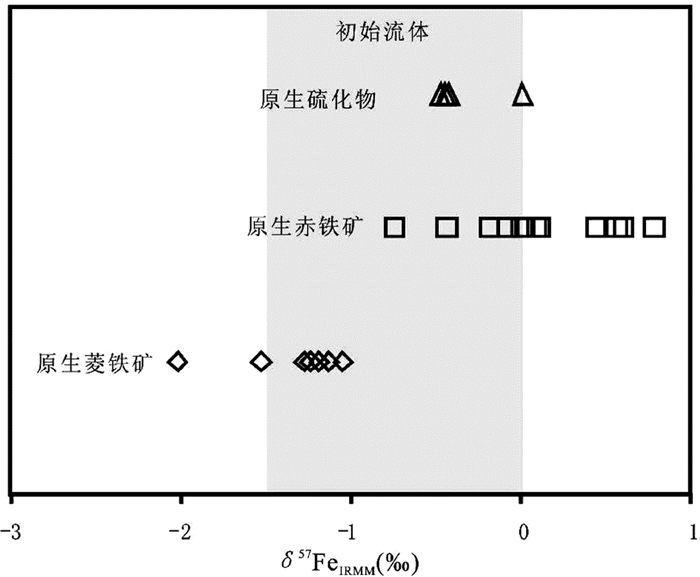
|
图 7 Schwarzwald矿床不同沉淀机制下形成的原生矿物的铁同位素组成(据Markl et al., 2006,灰色阴影代表预测的初始流体铁同位素组成变化范围) Fig. 7 Iron isotopic compositions of primary iron minerals precipitated from different fluids, Schwarzwald (after Markl et al., 2006) |
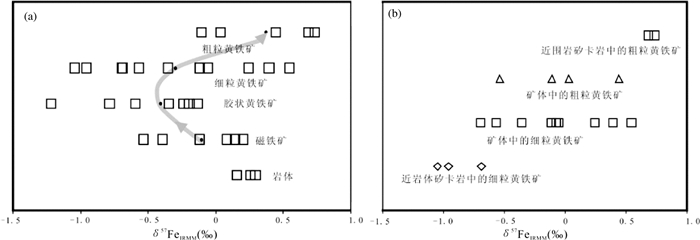
|
图 8 新桥矿床铁同位素组成的时空分带(据Wang et al., 2011) Fig. 8 Temporal and space zonation of Fe isotope compositions of Xinqiao deposit (after Wang et al., 2011) |
上述分馏实验、理论计算和实测研究均表明,矿物的结晶沉淀会导致铁同位素发生分馏。在成矿流体演化过程中,随着Fe (Ⅲ) 矿物的结晶沉淀,流体逐渐富集铁的轻同位素;随着Fe (Ⅱ) 矿物的结晶沉淀,流体逐渐富集铁的重同位素。这样,在瑞利分馏的情况下,成矿流体的铁同位素组成将随矿物的不断沉淀而随时间发生演化。流体演化过程中的铁同位素组成变化规律为应用铁同位素进行流体演化过程和矿化作用过程的反演提供了重要的理论基础,为成矿作用的研究提供了直接有效的工具。
4.3 表生蚀变作用过程中的铁同位素分馏Markl et al.(2006)对Schwarzwald热液脉型矿床中次生蚀变作用下形成的含铁矿物进行了铁同位素组成的调查研究。结果显示,高温和低温蚀变作用对铁同位素组成的影响差别较大(图 9)。对于原生的菱铁矿来说,其δ57Fe变化范围为-2.01‰~-1.04‰,原生菱铁矿经蚀变作用后,形成了次生的赤铁矿和针铁矿。其中,经高温蚀变作用形成的赤铁矿,δ57Fe变化范围为1.13‰~1.30‰,相对于原生菱铁矿富集铁的重同位素;而经低温蚀变作用形成的赤铁矿,δ57Fe变化范围为-2.25‰~-0.35‰,经低温蚀变作用形成的针铁矿,δ57Fe变化范围为-1.66‰~-0.73‰,两者的铁同位素组成的变化范围都与原生菱铁矿的铁同位素组成变化范围接近,基本上保留了原矿物(菱铁矿) 的铁同位素组成。对于原生的硫化物来讲,δ57Fe约为-0.45‰的硫化物经表生低温蚀变作用形成的两种铁的砷化物δ57Fe值分别为-0.22‰和-0.37‰,也基本上保留了其原矿物(硫化物) 的铁同位素组成。研究认为,铁同位素变化可以用来示踪成矿后的表生蚀变作用过程,高温蚀变作用形成的产物相对于原矿物富集铁重同位素,低温蚀变作用形成的产物基本保留了原矿物的铁同位素组成。
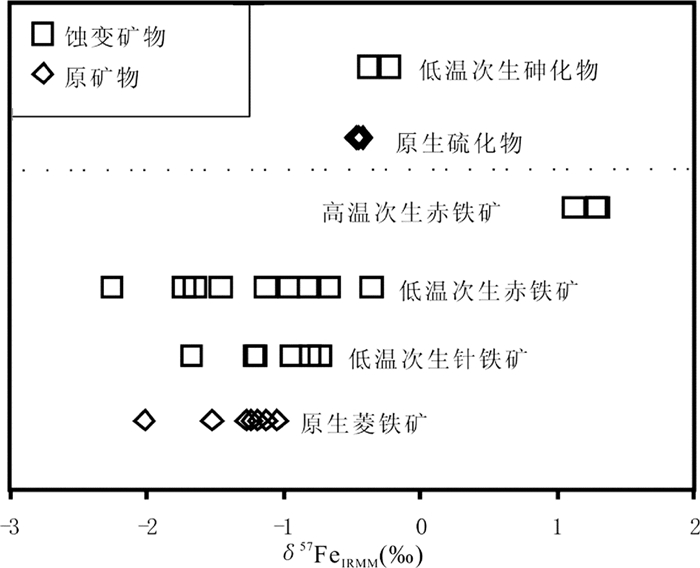
|
图 9 Schwarzwald矿床高温蚀变作用与低温蚀变作用形成的产物与原矿物的铁同位素组成对比(据Markl et al., 2006) Fig. 9 Comparation of iron isotopic compositions of primary and secondary iron minerals from Schwarzwald area (after Markl et al., 2006) |
成矿物质来源是矿床学中重点研究对象。目前,主要应用一些成熟的同位素体系和地球化学方法来解决这个问题,例如微量元素、稀土元素、Pb同位素和S同位素等。但这些传统方法并没有对成矿金属的来源进行直接约束,Fe作为直接参与成矿的元素,其同位素组成在成矿作用过程中的变化规律为利用Fe同位素体系进行金属物质来源的直接示踪提供了可能。
Graham et al. (2004)对Irian Jaya中南部GIC杂岩体内3个侵入体和其周围矽卡岩中的黄铁矿和黄铜矿进行了铁同位素研究。研究发现,矽卡岩矿体和杂岩体中的黄铁矿和黄铜矿在铁同位素组成的重同位素端元有一定的重叠(图 10a),他们认为这种铁同位素组成的重叠代表在某些阶段,矽卡岩矿化与岩体的矿化相一致并且与同一成矿流体有关。他们同时发现,相对杂岩体中的黄铁矿,矽卡岩矿体中黄铁矿的Fe同位素组成有倾向铁的轻同位素端元的趋势(图 10b),认为这一现象可能反映了来自岩浆的含矿流体在演化过程中混入了围岩中的Fe,即铁的来源是火成的Fe和沉积的Fe的共同贡献,并且矿化作用发生之前,围岩中应该富集铁的轻同位素。
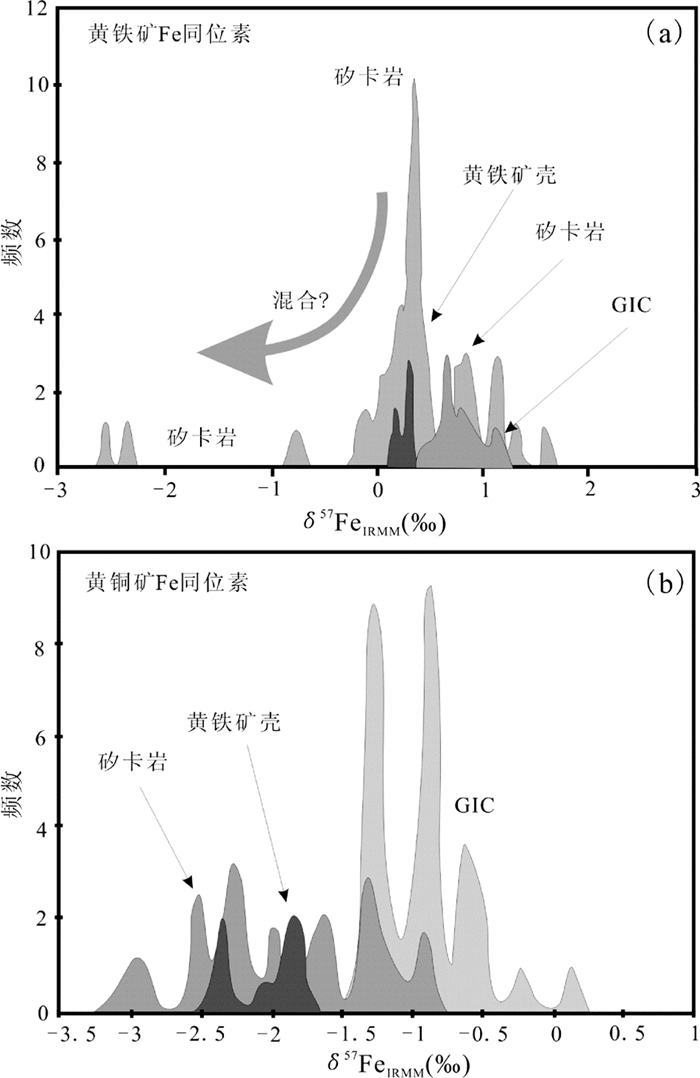
|
图 10 GIC和相关矽卡岩型矿床中的黄铁矿和黄铜矿的铁同位素组成(据Graham et al., 2004) Fig. 10 Iron isotope compositions of pyrites and chalcopyrites in GIC-associated skarn-type deposit (after Graham et al., 2004) |
Markl et al.(2006)对Schwarzwald热液脉型矿床中的含铁矿物进行了铁同位素组成的研究。研究结果显示,铁同位素组成变化范围较大,这种变化可以出现在同一脉体中,甚至出现在同一赤铁矿样品中;研究同时发现,形成于同一成矿流体体系的原生赤铁矿和原生菱铁矿铁同位素组成也不尽相同。因此,他们认为成矿作用过程中的铁同位素组成变化较大,无法用来直接判别Fe的来源。
Wang et al.(2011)对新桥矿床中含铁矿物的铁同位素组成研究结果表明,岩浆热液体系流体出溶和流体演化过程中铁同位素均发生了分馏。他们认为,流体从岩体中出溶的过程中铁同位素发生分馏,并且流体富集铁的轻同位素特征无法通过围岩组分的加入来解释,表明矽卡岩型矿床初始流体中的Fe主要来自火成岩体。研究同时发现,流体自岩体出溶后,随着含铁矿物的沉淀,流体的铁同位素演化趋势符合同位素分馏的基本理论和分馏实验结果,说明矿化作用过程中各矿物相沉淀出来的Fe主要来自单一来源。因此,他们认为新桥矿床Fe主要来源于岩浆。
孙剑等(2011)对白云鄂博多金属矿床中的Fe同位素组成进行了测试,结果表明白云鄂博铁矿石主体细粒铁矿石的铁同位素组成基本均一。他们认为,这种Fe同位素组成的均一代表了源区Fe同位素组成均一,而不是后期的地质作用(变质作用和热液作用) 均一化的结果。结合矿区外围沉积铁矿的铁同位素基本组成和其变化范围较大的特征,他们认为白云鄂博的铁同位素组成具有岩浆来源的特点。
结合上述研究,我们认为Fe同位素可以用来示踪成矿物质来源。但是,由于在成矿作用过程中,Fe同位素组成主要受流体演化、矿物沉淀历史和后期地质作用过程的影响。因此,流体出溶、流体演化等重要成矿作用过程中Fe同位素组成的变化规律是利用Fe同位素示踪Fe来源的关键所在。
5 结语与展望随着MC-ICP-MS测试技术的发展,Fe同位素地球化学研究成为一个崭新而快速发展的领域。通过十余年的研究,人们已对Fe同位素的分布特征和分馏机制有了基本认识(包括初步查明了地外物质和地球各主要储库的铁同位素组成,并对沉淀溶解、氧化还原、吸附和生物作用等过程中的Fe同位素分馏有了初步认识),为Fe同位素示踪技术的应用奠定了必要的基础。目前,Fe同位素体系已经初步应用于地质、环境、生物和宇宙科学等方面。作为直接参与成矿的元素,Fe同位素地球化学为成矿作用的直接示踪提供了新的途径,已在成矿物质来源和流体出溶、流体演化、表生蚀变等重要成矿作用过程的示踪研究方面显示出了明显的优越性。虽已取得了一定的进展,但由于Fe同位素示踪成矿作用的研究尚处在探索阶段,仍存在以下几个方面的工作有待于进一步的深入研究:(1) 深入研究铁同位素在共生矿物间的分配规律,为铁同位素体系在矿床学中的应用奠定必要的理论基础,同时丰富同位素地质基本理论;(2) 系统开展不同类型矿床的Fe同位素地球化学研究,为Fe同位素体系在矿床学领域的应用提供必要的知识与数据积累,进而建立具有普适性的铁同位素体系示踪规律和工作方法;(3) 积极开展Fe同位素与元素和其它同位素体系相结合的综合研究,有效实现对成矿物质来源和成矿作用过程的系统约束。
可以预见,随着今后研究工作的进一步深化,Fe同位素将成为矿床学研究中具有巨大应用前景的一种地球化学手段。
| [] | Alexander CMO'D, Wang J. 2001. Iron isotopes in chondrules: Implications for the role of evaporation during chondrule formation. Meteoritics & Planetary Science, 36(3): 419–428. |
| [] | Alexander CMO'D. 2004. Chemical equilibrium and kinetic constraints for chondrule and CAI formation conditions. Geochimica et Cosmochimica Acta, 68(19): 3943–3969. DOI:10.1016/j.gca.2004.03.030 |
| [] | Anbar AD, Jarzecki AA, Spiro TG. 2005. Theoretical investigation of iron isotope fractionation between Fe (H2O)63+ and Fe (H2O)63+: Implications for iron stable isotope geochemistry. Geochimica et Cosmochimica Acta, 69(4): 825–837. DOI:10.1016/j.gca.2004.06.012 |
| [] | Anbar AD, Rouxel O. 2007. Metal stable isotopes in paleoceanography. Annual Review of Earth and Planetary Science, 35: 717–746. DOI:10.1146/annurev.earth.34.031405.125029 |
| [] | Archer C, Vance D. 2006. Coupled Fe and S isotope evidence for Archean microbial Fe (Ⅲ) and sulfate reduction. Geology, 34(3): 153–156. DOI:10.1130/G22067.1 |
| [] | Bachinski DJ. 1969. Bond strength and sulfur isotopic fractionation in coexisting sulfides. Econ. Geol., 64: 56–65. DOI:10.2113/gsecongeo.64.1.56 |
| [] | Balci N, Bullen TD, Witte-Lien K, Shanks WC, Motelica M, Mandernack LW. 2006. Iron isotope fractionation during microbially stimulated Fe (II) oxidation and Fe (Ⅲ) precipitation. Geochimica et Cosmochimica Acta, 70(3): 622–639. DOI:10.1016/j.gca.2005.09.025 |
| [] | Beard BL, Johnson CM. 1999. High-precision iron isotope measurements of terrestrial and lunar materials. Geochimica et Cosmochimica Acta, 63(11-12): 1653–1660. DOI:10.1016/S0016-7037(99)00089-7 |
| [] | Beard BL, Johnson CM, Von Damm KL, Poulson RL. 2003a. Iron isotope constraints on Fe cycling and mass balance in oxygenated Earth oceans. Geology, 31(7): 629–632. DOI:10.1130/0091-7613(2003)031<0629:IICOFC>2.0.CO;2 |
| [] | Beard BL, Johnson CM, Skulan JL, Nealson KH, Cox L, Sun H. 2003b. Application of Fe isotopes to tracing the geochemical and biological cycling of Fe. Chemical Geology, 195(1-4): 87–117. DOI:10.1016/S0009-2541(02)00390-X |
| [] | Beard BL, Johnson CM. 2004a. Inter-mineral Fe isotope variations in mantle-derived rocks and implications for the Fe geochemical cycle. Geochimica et Cosmochimica Acta, 68(22): 4727–4743. DOI:10.1016/j.gca.2004.04.023 |
| [] | Beard BL, Johnson CM. 2004b. Fe isotope variations in the modern and ancient Earth and other planetary bodies. In: Johnson CM, Beard BL and Albare′de F (eds.). Geochemistry of Non-Traditional Stable Isotopes. Reviews in Mineralogy and Geochemistry, 55(1): 319–357. |
| [] | Beard BL, Johnson CM. 2006. Commetn on "Heavy iron isotope composition of granites determined by high resolution MC-ICP-MS", by Poitrasson F and Freydier R, [Chem. Geol.] 222 132-147. Chemical Geolgy, 235(1-2): 201–204. |
| [] | Beard BL and Johnson CM. 2007. Comment on "Iron isotope fractionation during planetrary differentiation" by Weyer S et al., [Earth Planet. Sci. Lett.] 240, 251-264. Earth and Planetary Science Letters, 256(3-4): 633-637 |
| [] | Bekker A, Barley ME, Fiorentini ML, Rouxel O, Rumble D, Beresford SW. 2009. Atmospheric sulfur in Archean komatiite-hosted nickel deposits. Science, 326(5956): 1086–1089. DOI:10.1126/science.1177742 |
| [] | Bekker A, Slack JF, Planavsky N, Krapež B, Hofmann A, Konhauser KO, Rouxel OJ. 2010. Iron formation: The sedimentary product of a complex interplay among mantle, tectonic, oceanic, and biospheric processes. Economic Geology, 105(3): 467–508. DOI:10.2113/gsecongeo.105.3.467 |
| [] | Belshaw NS, Zhu XK, Guo Y, O'Nions RK. 2000. High precision measurement of iron isotopes by plasma source mass spectrometry. International Journal of Mass Spectrometry, 197(1-3): 191–195. DOI:10.1016/S1387-3806(99)00245-6 |
| [] | Bennett SA, Rouxel O, Schmidt K, Garbe-Schãnberg D, Statham PJ, German CR. 2009. Iron isotope fractionation in a buoyant hydrothermal plume, 5°S Mid-Atlantic Ridge. Geochimica et Cosmochimica Acta, 73(19): 5619–5634. DOI:10.1016/j.gca.2009.06.027 |
| [] | Bergquist BA, Boyle EA. 2006. Iron isotopes in the Amazon River system Weathering and transport signatures. Earth and Planetary Science Letters, 248: 5468. |
| [] | Butler BI, Archer C, Vance D, Lldroyd A, Rickard D. 2005. Fe isotope fractionation on FeS formation in ambient aqueous solution. Earth and Planetary Science Letters, 236(1-2): 430–442. DOI:10.1016/j.epsl.2005.05.022 |
| [] | Chen XF, Zhu XK. 2011. Studies on Fe and Cu isotopes of Tonglvshan skarn-type deposit. Acta Mineralogica Sinica, 32(S): 1001–1003. |
| [] | Chou IM, Eugster HP. 1977. Solubility of magnetite in supercritical chloride solutions. Am. J. Sci., 277(10): 1296–1314. DOI:10.2475/ajs.277.10.1296 |
| [] | Chu NC, Johnson CM, Beard BL, German CR, Nesbitt RW, Frank M, Marcel B, Kubik PW, Usui A, Graham I. 2006. Evidence for hydrothermal venting in Fe isotope compositions of the deep Pacific Ocean through time. Earth and Planetary Science Letters, 245(1-2): 202–217. DOI:10.1016/j.epsl.2006.02.043 |
| [] | Craddock PR, Dauphas N. 2011. Iron and carbon isotope evidence for microbial iron respiration throughout the Archean. Earth and Planetary Science Letters, 303(1-2): 121–132. DOI:10.1016/j.epsl.2010.12.045 |
| [] | Czaja AD, Johnson CM, Beard BL, Eigenbrode JL, Freeman KH, Yamaguchi KE. 2010. Iron and carbon isotope evidence for ecosystem and environmental diversity in the~2. 7 to 2.5Ga Hamersley Province, Western Australia. Earth and Planetary Science Letters, 292(1-2): 170–180. |
| [] | Dauphas N, Janney PE, Mendybaev RA, Wadhwa M, Richter FM, Davis AM, van Zuilen M, Hines R, Foley CN. 2004a. Chromatographic separation and multicollection-ICPMS analysis of iron. Investigating massdependent and -independent isotope effects. Anal. Chem., 76(19): 5855–5863. |
| [] | Dauphas N, van Zuilen M, Wadhwa M, Davis AM, Marty B, Janney PE. 2004b. Clues from Fe isotope variations on the origin of Early Archean BIFs from Greenland. Science, 306(5704): 2077–2080. DOI:10.1126/science.1104639 |
| [] | Dauphas N, Rouxel O. 2006. Mass spectrometry and natural variations of iron isotopes. Mass Spectrom. Rev., 25(4): 515–550. DOI:10.1002/(ISSN)1098-2787 |
| [] | Dauphas N, Cates NL, Mojzsis SJ, Busigny V. 2007. Identification of chemical sedimentary protoliths using iron isotopes in the >3750Ma Nuvvuagittuq supracrustal belt, Canada. Earth and Planetary Science Letters, 254(3-4): 358–376. DOI:10.1016/j.epsl.2006.11.042 |
| [] | Dauphas N, Teng FZ, Arndt NT. 2010. Magnesium and iron isotopes in 2. 7Ga Alexo komatiites: Mantle signatures, no evidence for Soret diffusion, and identification of diffusive transport in zoned olivine. Geochimica et Cosmochimica Acta, 74(11): 3274–3291. |
| [] | Fantle MS, DePaolo DJ. 2004. Iron isotopic fractionation during continental weathering. Earth and Planetary Science Letters, 228(3-4): 547–562. DOI:10.1016/j.epsl.2004.10.013 |
| [] | Fehr MA, Andersson PS, Hålenius U, Mãrth CM. 2008. Iron isotope variations in Holocene sediments of the Gotland Deep, Baltic Sea. Geochimica et Cosmochimica Acta, 72(3): 807–826. DOI:10.1016/j.gca.2007.11.033 |
| [] | Frost CD, von Blanckenburg F, Schoenberg R, Frost BR, Swapp SM. 2007. Preservation of Fe isotope heterogeneities during diagenesis and metamorphism of banded iron-formation. Contrib. Mineral. Petrol., 155(1): 135. |
| [] | Graham S, Pearson N, Jackson S, Griffin W, OåReilly SY. 2004. Tracing Cu and Fe from source to porphyry: In situ determination of Cu and Fe isotope ratios in sulfides from the Grasberg Cu-Au deposit. Chemical Geology, 207(3-4): 147–169. DOI:10.1016/j.chemgeo.2004.02.009 |
| [] | Halverson GP, Poitrasson F, Hoffman PF, Nédélec A, Montel JM, Kirby J. 2011. Fe isotope and trace element geochemistry of the Neoproterozoic syn-glacial Rapitan iron formation. Earth and Planetary Science Letters, 309(1-2): 100–112. DOI:10.1016/j.epsl.2011.06.021 |
| [] | Heimann A, Beard BL, Johnson CM. 2008. The role of volatile exsolution and sub-solidus fluid/rock interactions in producing high 56Fe/54Fe ratios in siliceous igneous rocks. Geochimica et Cosmochimica Acta, 72(17): 4379–4396. DOI:10.1016/j.gca.2008.06.009 |
| [] | Heimann A, Johnson CM, Beard BL, Valley JW, Roden EE, Spicuzza MJ, Beukes NJ. 2010. Fe, C and O isotope compositions of banded iron formation carbonates demonstrate a major role for dissimilatory iron reduction in~2. 5Ga marine environments. Earth and Planetary Science Letters, 294(1-2): 8–18. DOI:10.1016/j.epsl.2010.02.015 |
| [] | Hezel DC, Needham AW, Armytage R, Georg B, Abel RL, Kurahashi E, Coles BJ, Rehkamper M, Russell SS. 2010. A nebula setting as the origin for bulk chondrule Fe isotope variations in CV chondrites. Earth and Planetary Science Letters, 196(3-4): 423–433. |
| [] | Hofmann A, Bekker A, Rouxel O, Rumble D, Mastger S. 2009. Multiple sulphur and iron isotope composition of detrital pyrite in Archaean sedimentary rocks: A new tool for provenance analysis. Earth and Planetary Science Letters, 286(3-4): 436–445. DOI:10.1016/j.epsl.2009.07.008 |
| [] | Huang F, Lundstrom CC, Glessner J, Ianno A, Boudreau A, Li J, Ferre EC, Marshak S, Defrates J. 2009. Chemical and isotopic fractionation of wet andesite in a temperature gradient: Experiments and models suggesting a new mechanism of magma differentiation. Geochim. Cosmochim. Acta, 73: 729–749. DOI:10.1016/j.gca.2008.11.012 |
| [] | Huang F, Zhang ZF, Lundstrom CC, Zhi XC. 2011. Iron and magnesium isotopic compositions of peridotite xenoliths from Eastern China. Geochimica et Cosmochimica Acta, 75(12): 3318–3334. DOI:10.1016/j.gca.2011.03.036 |
| [] | Hyslop EV, Valley JW, Johnson CM, Beard BL. 2008. The effects of metamorphism on O and Fe isotope compositions in the Biwabik Iron Formation, northern Minnesota. Contrib. Mineral. Petrol., 155(3): 313–328. DOI:10.1007/s00410-007-0244-2 |
| [] | Johnson CM, Skulan JL, Beard BL, Sun H, Nealson KH, Braterman PS. 2002. Isotopic fractionation between Fe (Ⅲ) and Fe (II) in aqueous solutions. Earth and Planetary Science Letters, 195(1-2): 141–153. DOI:10.1016/S0012-821X(01)00581-7 |
| [] | Johnson CM, Beard BL, Beukes NJ, Klein C, O'Leary JM. 2003. Ancient geochemical cycling in the earth as inferred from Fe isotope studies of banded iron formations from the Transvaal Craton. Contrib. Mineral. Petrol., 144(5): 523–547. DOI:10.1007/s00410-002-0418-x |
| [] | Johnson CM, Beard BL, Roden EE, Newman DK, Nealson KH. 2004. Isotopic constraints on biogeochemical cycling of Fe. In: Johnson CM, Beard BL, Albaréde F (eds.). Geochemistry of Non-Traditional Stable Isotopes. Reviews in Mineralogy and Geochemistry, 55: 359–408. |
| [] | Johnson C, Beard B. 2006. Fe isotopes: An emerging technique for understanding modern and ancient biogeochemical cycles. GSA Today, 16: 4–10. |
| [] | Johnson CM, Beard BL, Klein C, Beukes NJ, Roden EE. 2008. Iron isotopes constrain biologic and abiologic processes in banded iron formation genesis. Geochimica et Cosmochimica Acta, 72(1): 151–169. DOI:10.1016/j.gca.2007.10.013 |
| [] | Johnson CM, Bell K, Beard BL, Shultis AI. 2010. Iron isotope compositions of carbonatites record melt generation, crystallization, and late-stage volatile-transport processes. Mineralogy and Petrology, 98: 91–110. DOI:10.1007/s00710-009-0055-4 |
| [] | Li ZH, Zhu XK, Tang SH. 2008a. Characters of Fe isotopes and rare earth elements of banded iron formations from Anshan-Benxi area: Implications for Fe source. Acta Petrologica et Mineralogica, 27(4): 285–290. |
| [] | Li ZH, Zhu XK, Tang SH, Li YH. 2008b. Fe isotope fractionation between magnetite and pyrite during green schist-lower amphibolite facies metamorphism. Acta Petrologica et Mineralogica, 27(4): 291–297. |
| [] | Li ZH, Zhu XK. 2012. Geochemical features of Xuanlong type iron ore deposit in Hebei Province and their geological significances. Acta Petrologica Sinica, 28(9): 2903–2911. |
| [] | Markl G, von Blanckenburg F, Wagner T. 2006. Iron isotope fractionation during hydrothermal ore deposition and alteration. Geochimica et Cosmochimica Acta, 70(12): 3011–3030. DOI:10.1016/j.gca.2006.02.028 |
| [] | Mullane E, Russell SS, Gounelle M. 2005. Nebular and asteroidal modification of the iron isotope composition of chondritic components. Earth and Planetary Science Letters, 239(3-4): 203–218. DOI:10.1016/j.epsl.2005.07.026 |
| [] | Needham AW, Porcelli D, Russell SS. 2009. An Fe isotope study of ordinary chondrites. Geochimica et Cosmochimica Acta, 73(24): 7399–7413. DOI:10.1016/j.gca.2009.08.034 |
| [] | O'Neil JR. 1986. Theoretical and experimental aspects of isotopic fractionation. Rev. Miner. Geochem., 16(1): 1–40. |
| [] | Ouyang ZY. 1988. Cosmochemistry. Beijing: Science Press, 1-230(in Chinese) |
| [] | Planavsky N, Rouxel OJ, Bekker A, Shapiro R, Fralick P, Knudsen A. 2009. Iron-oxidizing microbial ecosystems thrived in Late Paleoproterozoic redox-stratified oceans. Earth and Planetary Science Letters, 286(1-2): 230–242. DOI:10.1016/j.epsl.2009.06.033 |
| [] | Planavsky N, Rouxel OJ, Bekker A, Hoffman A, Crispin TS, Lyons TW. 2011. Iron isotope composition of some Archean and Proterozoic iron formations. Geochimica et Cosmochimica Acta, 80: 158–169. |
| [] | Poitrasson F, Halliday AN, Lee DC, Levasseur S, Teutsch N. 2004. Iron isotope differences between Earth, Moon, Mars and Vesta as possible records of contrasted accretion mechanisms. Earth and Planetary Science Letters, 222(3-4): 253–266. |
| [] | Poitrasson F, Freydier R. 2005. Heavy iron isotope composition of granites determined by high resolution MC-ICP-MS. Chemical Geology, 222(1-2): 132–147. DOI:10.1016/j.chemgeo.2005.07.005 |
| [] | Poitrasson F. 2006. On the iron isotope homogeneity level of the continental crust. Chemical Geology, 235(1-2): 195–200. DOI:10.1016/j.chemgeo.2006.06.010 |
| [] | Poitrasson F. 2007. Does planetary differentiation really fractionate iron isotopes?. Earth and Planetary Science Letters, 256(3-4): 484–492. DOI:10.1016/j.epsl.2007.01.039 |
| [] | Polyakov VB, Mineev SD. 2000. The use of Mãssbauer spectroscopy in stable isotope geochemistry. Geochimica et Cosmochimica Acta, 64(5): 849–865. DOI:10.1016/S0016-7037(99)00329-4 |
| [] | Polyakov VB, Clayton RN, Horita J, Mineev SD. 2007. Equilibrium iron isotope fractionation factors fo minerals: Reevaluation from the data of nuclear inelastic resonant X-ray scattering and Mãssbauer spectroscopy. Geochimica et Cosmochimica Acta, 71(15): 3833–3846. DOI:10.1016/j.gca.2007.05.019 |
| [] | Polyakov VB, Soultanov DM. 2011. New data on equilibrium iron isotope fractionation among sulfides: Constraints on mechanisms of sulfide formation in hydrothermal and igneous systems. Geochimica et Cosmochimica Acta, 75(7): 1957–1974. DOI:10.1016/j.gca.2011.01.019 |
| [] | Rouxel O, Dobbek N, Ludden J, Fouquet Y. 2003. Iron isotope fractionation during oceanic crust alteration. Chemical Geology, 202(1-2): 155–182. DOI:10.1016/j.chemgeo.2003.08.011 |
| [] | Rouxel O, Fouquet Y, Ludden JN. 2004. Subsurface processes at the Lucky Strike hydrothermal field, Mid-Atlantic Ridge: Evidence from sulfur, selenium, and iron isotopes. Geochimica et Cosmochimica Acta, 68(10): 2295–2311. DOI:10.1016/j.gca.2003.11.029 |
| [] | Rouxel OJ, Bekker A, Edwards KJ. 2005. Iron isotope constraints on the Archean and Paleoproterozoic ocean redox state. Science, 307(5712): 1088–1091. DOI:10.1126/science.1105692 |
| [] | Rouxel O, Shanks WC Ⅲ, Bach W, Edwards KJ. 2008. Integrated Fe-and S-isotope study of seafloor hydrothermal vents at East Pacific Rise 9~10N. Chemical Geology, 252(3-4): 214–227. DOI:10.1016/j.chemgeo.2008.03.009 |
| [] | Rouxel O. 2009. Natural variations of Fe isotopic compositions of seawater determined by MC-ICPMS. In: European Geosciences Union General Assembly. Geophys. Res. Abstr., 11, EGU2009-10517 |
| [] | Schoenberg R, von Blanckenburg F. 2006. Modes of planetary-scale Fe isotope fractionation. Earth and Planetary Science Letters, 252(3-4): 342–359. DOI:10.1016/j.epsl.2006.09.045 |
| [] | Schoenberg R, Marks MAW, Schuessler JA, von Blanckenburg F, Markl G. 2009. Fe isotope systematics of coexisting amphibole and pyroxene in the alkaline igneous rock suite of the Ilímaussaq Complex, South Greenland. Chemical Geology, 258(1-2): 65–77. DOI:10.1016/j.chemgeo.2008.06.023 |
| [] | Schuessler JA, Schoenberg R, Sigmarsson O. 2009. Iron and lithium isotope systematics of the Hekla volcano, Iceland: Evidence for Fe isotope fractionation during magma differentiation. Chemical Geology, 258(1-2): 78–91. DOI:10.1016/j.chemgeo.2008.06.021 |
| [] | Severmann S, Johnson CM, Beard BL, German CR, Edmonds HN, Chiba H, Green DRH. 2004. The effect of plume processes on the Fe isotope composition of hydrothermally derived Fe in the deep ocean as inferred from the Rainbow vent site, Mid-Atlantic Ridge, 36°14'N. Earth and Planetary Science Letters, 225(1-2): 63–76. DOI:10.1016/j.epsl.2004.06.001 |
| [] | Severmann S, Johnson CM, Beard BL, McManus J. 2006. The effect of early diagenesis on the Fe isotope compositions of porewaters and authigenic minerals in continental margin sediments. Geochimica et Cosmochimica Acta, 70(8): 2006–2022. DOI:10.1016/j.gca.2006.01.007 |
| [] | Sharam M, Polizzotto M, Anbar AD. 2001. Iron isotopes in hot springs along the Juan de Fuca Ridge. Earth and Planetary Science Letters, 194(1-2): 39–51. DOI:10.1016/S0012-821X(01)00538-6 |
| [] | Schuessler JA, Schoenberg R, Sigmarsson O. 2009. Iron and lithium isotope systematic of the Hekla volcano, Iceland: Evidence for Fe isotope fractionation during magma differentiation. Chemical Geology, 258: 78–91. DOI:10.1016/j.chemgeo.2008.06.021 |
| [] | Steinhoefel G, Horn I, von Blanckenburg F. 2009. Micro-scale tracing of Fe and Si isotope signatures in banded iron formation using femtosecond laser ablation. Geochimica et Cosmochimica Acta, 73(18): 5343–5360. DOI:10.1016/j.gca.2009.05.037 |
| [] | Steinhoefel G, von Blanckenburg F, Horn I, Konhausr KO, Beukes NJ, Gutzmer J. 2010. Deciphering formation processes of banded iron formations from the Transvaal and the Hamersley successions by combined Si and Fe isotope analysis using UV femtosecond laser ablation. Geochimica et Cosmochimica Acta, 74(9): 2677–2696. DOI:10.1016/j.gca.2010.01.028 |
| [] | Sun J, Zhu XK, Chen YL, Fang N. 2011. Study on Fe isotope characteristic of Baiynebo polymetallic deposit. Acta Mineralogica Sinica, 32(Suppl): 1016–1017. |
| [] | Taylor PDP, Maeck R, De Bièvre P. 1992. Determination of the absolute isotopic composition and atomic weight of a reference sample of natural iron. Int. J. Mass. Spectrom. Ion Proces., 121(1-2): 111–125. DOI:10.1016/0168-1176(92)80075-C |
| [] | Teng FZ, Dauphas N, Helz RT. 2008. Iron isotope fractionation during magmatic differentiation in Kilauea lki Lava Lake. Science, 320(5883): 1620–1622. DOI:10.1126/science.1157166 |
| [] | Teng FZ, Dauphas N, Helz RT, Gao S, Huang SC. 2011. Diffusion-driven magnesium and iron isotope fractionation in Hawaiian olivine. Earth and Planetary Science Letters, 308(3-4): 317–324. DOI:10.1016/j.epsl.2011.06.003 |
| [] | Tsikos H, Matthews A, Erel Y, Moore JM. 2010. Iron isotopes constrain biogeochemical redox cycling of iron and manganese in a Palaeoproterozoic stratified basin. Earth and Planetary Science Letters, 298(1-2): 125–134. DOI:10.1016/j.epsl.2010.07.032 |
| [] | Valley GE, Anderson HH. 1947. A comparison of the abundance ratios of the isotopes of terrestrial and meteoritic iron. J. Am. Chem. Soc., 69(8): 1871–1875. DOI:10.1021/ja01200a010 |
| [] | von Blanckenburg F, Mamberti M, Schoenberg R, Kamber BS, Webb GE. 2008. The iron isotope composition of microbial carbonate. Chemical Geology, 249(1-2): 113–128. DOI:10.1016/j.chemgeo.2007.12.001 |
| [] | Walczyk T, von Blanckenburg F. 2002. Natural iron isotope variations in human blood. Science, 295(5562): 2065–2066. DOI:10.1126/science.1069389 |
| [] | Walker EC, Cuttitta F, Senftle FE. 1958. Some natural variations in the relative abundance of copper isotopes. Geochimica et Cosmochimica Acta, 15(3): 183–194. DOI:10.1016/0016-7037(58)90056-5 |
| [] | Williams HM, McCammon CA, Peslier AH, Halliday AN, Teutsch N, Levasseur S, Burg JP. 2004. Iron isotope fractionation and the oxygen fugacity of the mantle. Science, 304(5677): 1656–1659. DOI:10.1126/science.1095679 |
| [] | Williams HM, Peslier AH, McCammon C, Halliday AN, Levasseur S, Teutsch N, Burg JP. 2005. Systematic iron isotope variations in mantle rocks and minerals: The effects of partial melting andoxygen fugacity. Earth and Planetary Science Letters, 235(1-2): 435–452. DOI:10.1016/j.epsl.2005.04.020 |
| [] | Williams HM, Nielsen SG, Renac C, Griffin WL, O'Reilly SY, Mc Cammon CA, Person N, Viljoen F, Alt JC, Halliday AN. 2009. Fractionation of oxygen and iron isotopes by partial melting processes: Implications for the interpretation of stable isotope signatures in mafic rocks. Earth and Planetary Science Letters, 283(1-4): 156–166. DOI:10.1016/j.epsl.2009.04.011 |
| [] | Wang Y, Zhu XK, Mao JW, Li ZH, Cheng YB. 2011. Iron isotope fractionation during skarn-type metallogeny: A case study of Xinqiao Cu-S-Fe-Au deposit in the Middle-Lower Yangtze Valley. Ore Geology Reviews, 43(1): 194–202. DOI:10.1016/j.oregeorev.2010.12.004 |
| [] | Wang SX, Zhu XK, Song XY. 2011. Characteritics Fe isotopes of Panzhihua V-Ti magnitie deposit and its significance. Acta Mineralogica Sinica, 32(Suppl.): 1020–1021. |
| [] | Welch SA, Beard BL, Johnson CM, Braterman PS. 2003. Kinetic and equilibrium Fe isotope fractionation between aqueous Fe (II) and Fe (Ⅲ). Geochimica et Cosmochimica Acta, 67(22): 4231–4250. DOI:10.1016/S0016-7037(03)00266-7 |
| [] | Weyer S, Anbar AD, Brey GP, Münker C, Mezger K, Woodland AB. 2005. Iron isotope fractionation during planetary differentiation. Earth and Planetary Science Letters, 240(2): 251–264. DOI:10.1016/j.epsl.2005.09.023 |
| [] | Weyer S, Ionov DA. 2007. Partial melting and melt percolation in the mantle: The message from Fe isotopes. Earth and Planetary Science Letters, 259(1-2): 119–133. DOI:10.1016/j.epsl.2007.04.033 |
| [] | Weyer S. 2008. Geochemistry-what drives iron isotopic fractionation in magma?. Science, 320(5883): 1600–1601. DOI:10.1126/science.1160204 |
| [] | Weyer S, Seitz HM. 2011. Coupled lithium-and iron isotope fractionation during magmatic differentiation. Chemical Geolgoy, 294-295: 42–50. |
| [] | Whitehouse MJ, Fedo CM. 2007. Microscale heterogeneity of Fe isotopes in >3. 71Ga banded iron formation from the Isua Greenstone Belt, southwest Greenland. Geology, 35(8): 719–722. |
| [] | Wiesli RA, Beard BL, Johnson CM. 2004. Experimental determination of Fe isotope fractionation between aqueous Fe (II), siderite, and green rust in abiotic system. Chem. Geol., 221(3-4): 343–362. |
| [] | Williams HM, McCammon CA, Pesiler AH, Halliday AN, Levasseur S, Burg JP. 2004. Iron isotope fractionation and the oxygen fugacity of the mantle. Science, 304(5677): 1656–1659. DOI:10.1126/science.1095679 |
| [] | Williams HM, Peslier AH, Mccammon C, Halliday AN, Levasseur S, Teutsch N, Burg JP. 2005. Systematic iron isotope variations in mantle rocks and minerals: The effects of partial melting and oxygen fugacity. Earth and Planetary Science Letters, 235(1-2): 435–452. DOI:10.1016/j.epsl.2005.04.020 |
| [] | Yamaguchi KE, Johnson CM, Beard BL, Ohmoto H. 2005. Biogeochemical cycling of iron in the Archean-Paleoproterozoic Earth: Constraints from iron isotope variations in sedimentary rocks from the Kaapvaal and Pilbara Cratons. Chemical Geolgy, 218(1-2): 135–169. DOI:10.1016/j.chemgeo.2005.01.020 |
| [] | Yan B, Zhu XK, Tang SH, Zhu MY. 2010. Fe isotopic characteristics of the Neoproterozoic BIF in Guangxi Province and its implications. Acta Geologica Sinica, 84(7): 1080–1086. |
| [] | Zhao XM, Zhu XK, Zhang HF, Tang SH. 2008. Applications of Fe isotopes to tracing mantle processes. Acta Petrologica et Mineralogica, 27(5): 435–440. |
| [] | Zhao XM, Zhang HF, Zhu XK, Tang SH, Tang YJ. 2010. Iron isotope variations in spinel peridotite xenoliths from North China Craton: Implications for mantle metasomatism. Contributions to Mineralogy and Petrology, 160(1): 1–14. DOI:10.1007/s00410-009-0461-y |
| [] | Zhao XM, Zhang HF, Zhu XK, Tang SH, Yan B. 2011. Iron isotope evidence for multistage melt-peridotite interactions in the lithospheric mantle of eastern China. Chemical Geolgy, 292-293: 127–139. |
| [] | Zhu XK, O′Nions RK, Guo YL, Reynolds BC. 2000. Secular variation of iron isotopes in north Atlantic Deep Water. Science, 287(5460): 2000–2002. DOI:10.1126/science.287.5460.2000 |
| [] | Zhu XK, Guo YL, O'Nions RK, Yound ED, Ash RD. 2001. Isotopic homogeneity of iron in the early solar nebula. Nature, 412(6844): 311–313. DOI:10.1038/35085525 |
| [] | Zhu XK, Guo Y, Williams RJP, O'Nions RK, Matthews A, Belshaw NS, Canters GW, de Waal EC, Weser U, Burgess BK, Salvato B. 2002. Mass fractionation processes of transition metal isotopes. Earth and Planetary Science Letters, 200(1-2): 47–62. DOI:10.1016/S0012-821X(02)00615-5 |
| [] | Zhu XK, Li ZH, Tang SH, Li YH. 2008. Fe isotope characteristics of Early Precambrian pyrite deposits and their geological significance: Examples from Shandong and Hebei provinces. Acta Petrologica et Mineralogica, 27(5): 429–434. |
| [] | Zipfel J, Weyer S. 2006. Fe-isotopic fractionation in CB chondrites. Meteorit. Planet. Sci., 39(Suppl.): A199. |
| [] | 陈晓峰, 朱祥坤. 2011. 铜绿山夕卡岩型铜铁矿床Fe、Cu同位素研究. 矿物学报, 32(增刊): 1001–1003. |
| [] | 李志红, 朱祥坤, 唐索寒. 2008a. 鞍山-本溪地区条带状铁建造的铁同位素与稀土元素特征及其对成矿物质来源的指示. 岩石矿物学杂志, 27(4): 285–290. |
| [] | 李志红, 朱祥坤, 唐索寒, 李延河. 2008b. 绿片岩-低角闪岩相变质条件下磁铁矿与黄铁矿间的Fe同位素分馏. 岩石矿物学杂志, 27(4): 291–297. |
| [] | 李志红, 朱祥坤. 2012. 河北省宣龙式铁矿的地球化学特征及其地质意义. 岩石学报, 28(9): 2903–2911. |
| [] | 欧阳自远. 1988.天体化学.北京:科学出版社, 1-230 |
| [] | 孙剑, 朱祥坤, 陈岳龙, 房楠. 2011. 白云鄂博多金属矿床铁同位素研究. 矿物学报, 32(增刊): 1016–1017. |
| [] | 王世霞, 朱祥坤, 宋谢炎. 2011. 攀枝花钒钛磁铁矿Fe同位素分布特征及其意义. 矿物学报, 32(增刊): 1020–1021. |
| [] | 闫斌, 朱祥坤, 唐索寒, 朱茂炎. 2010. 广西新元古代BIF的铁同位素特征及其地质意义. 地质学报, 84(7): 1080–1086. |
| [] | 赵新苗, 朱祥坤, 张宏福, 唐索寒. 2008. Fe同位素在地幔地球化学研究中的应用及进展. 岩石矿物学杂志, 27(5): 435–440. |
| [] | 朱祥坤, 李志红, 唐索寒, 李延河. 2008. 早前寒武纪硫铁矿矿床Fe同位素特征及其地质意义--以山东石河庄和河北大川为例. 岩石矿物学杂志, 27(5): 429–434. |
 2012, Vol. 28
2012, Vol. 28



